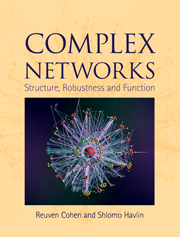Book contents
- Frontmatter
- Contents
- 1 Introduction
- PART I RANDOM NETWORK MODELS
- PART II STRUCTURE AND ROBUSTNESS OF COMPLEX NETWORKS
- PART III NETWORK FUNCTION: DYNAMICS AND APPLICATIONS
- 13 Optimization of the network structure
- 14 Epidemiological models
- 15 Immunization
- 16 Thermodynamic models on networks
- 17 Spectral properties, transport, diffusion and dynamics
- 18 Searching in networks
- 19 Biological networks and network motifs
- Appendix A Probability theoretical methods
- Appendix B Asymptotics and orders of magnitude
- Appendix C Algorithms for network simulation and investigation
- References
- Index
14 - Epidemiological models
from PART III - NETWORK FUNCTION: DYNAMICS AND APPLICATIONS
Published online by Cambridge University Press: 05 August 2013
- Frontmatter
- Contents
- 1 Introduction
- PART I RANDOM NETWORK MODELS
- PART II STRUCTURE AND ROBUSTNESS OF COMPLEX NETWORKS
- PART III NETWORK FUNCTION: DYNAMICS AND APPLICATIONS
- 13 Optimization of the network structure
- 14 Epidemiological models
- 15 Immunization
- 16 Thermodynamic models on networks
- 17 Spectral properties, transport, diffusion and dynamics
- 18 Searching in networks
- 19 Biological networks and network motifs
- Appendix A Probability theoretical methods
- Appendix B Asymptotics and orders of magnitude
- Appendix C Algorithms for network simulation and investigation
- References
- Index
Summary
Introduction
The study of the spread of epidemics is based on the notion that a disease is conveyed by contact between an infected individual and an uninfected individual who is susceptible to the disease. An endemic state is reached if a finite fraction of the population is infected. A state where (almost) all the population is infected is called a pandemic state. Similarly, this notion may describe the spread of a computer virus through a network of computers.
In previous chapters we surveyed the subject of attacks on networks, by targeting individuals either randomly or intentionally. In particular, the Internet and the WWW were shown to be robust to random breakdowns and vulnerable to targeted attacks, due to their broad distribution of node degrees. However, these chapters focused on the results of damaging computers by an outside source, and did not take into account the possibility of propagation of a problem throughout the connections among individuals in a population or among computers in a network, by way of the spreading of a disease or a computer virus.
Several models have been proposed for epidemic dynamics, differing in the disease stages, the dynamical parameters, and the underlying structure of contacts (see [AM92] for a survey). The most common models for disease dynamics are the susceptible–infected–recovered (SIR), susceptible–infected–susceptible (SIS), and susceptible–infected–recovered-susceptible (SIRS) models, which represent the stages of the disease for each individual in a network.
- Type
- Chapter
- Information
- Complex NetworksStructure, Robustness and Function, pp. 154 - 160Publisher: Cambridge University PressPrint publication year: 2010



